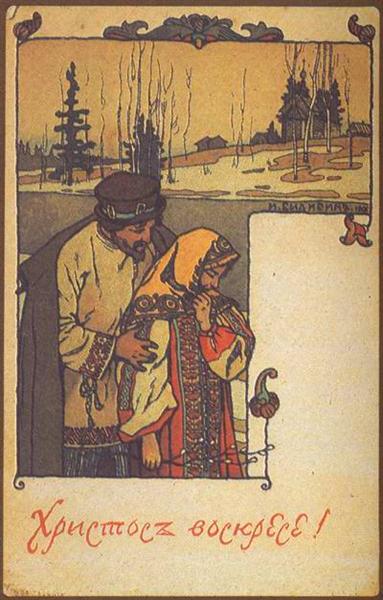Description
The painting "Postal Happy Easter - 1900" by Ivan Bilibin, a work that encapsulates the very essence of Russian folklore and the unique artistic vision of its creator, is a magnificent example of its commitment to tradition and visual narrative.
Ivan Bilibin, born in 1876 in a wealthy family of St. Petersburg, is recognized both for his skill and illustrator of Russian popular stories and for his ability to capture the spirit of his time. Graduated from the Imperial Academy of the Arts, his career flourished in a time of cultural rebirth in Russia, known for his vibrant and meticulous illustrations that fused modernism with the traditional motifs Slavs.
The "Happy Easter postcard - 1900" presents a master composition in which symbolism and detail attention are combined to offer a window to the celebration of Orthodox Easter. The work is dominated by an ornamental framework that channels the influence of Russian popular art, presenting floral motifs and geometric patterns that meticulously delineate the central scene. This framework not only serves as a container of the image but also becomes an integral part of the visual narrative, evoking the idea of an illustration or medieval miniature.
The center of the composition is adorned with two decorative eggs, a universal symbol of Easter, which here bilibin adorns with intricate patterns and bright colors. The colors used in this work, predominantly the warm and terrible tones, offer a vibrant contrast that gives life to the solemnity and joy of the holiday. The red, associated with the resurrection, and the gold, which evokes spiritual wealth and divine glory, play a crucial role in accentuating the Pascual theme of the work.
The unmistakable style of bilibin is manifested in the precision of the stroke and the solidity of the lines, which give the work of an almost architectural structuring. His training as an illustrator is reflected in the clarity with which the elements are delineated, which facilitates a clear and coherent visual reading. It is a style that transcends painting, remembering the beautiful illuminations of the Russian medieval manuscripts, and that demonstrates its ability to merge the medieval with the modernism of the twentieth century.
A fascinating observation about this work is the fact that Bilibin created many of his work in a time of deep political and social changes in Russia, and his dedication to traditional motifs can be seen as a conscious effort to preserve a rich and complex cultural identity In the midst of modernization. His work as a member of the Mir Iskusstva movement (art world) and its participation in the revitalization of Russian popular art are a testimony of their commitment to these cultural roots.
In terms of stylistic similarities, we can compare "Postcal Happy Easter - 1900" with other bilibin works such as their illustrations for stories such as "Vasilisa La Hermosa" and "El Zar jump." These illustrations share the same ornamental wealth and the detailed artisanal work that we find in this work, showing their unique ability to enrich visual narratives by incorporating folklore motifs.
In summary, "Postal Happy Easter - 1900" is not only a work of sublime art in its own right, but an invaluable cultural document that reflects the richness of the Russian tradition, filtered through the unique lens of Ivan Bilibin. Its ability to weave a rich and detailed visual narrative makes this work an essential piece in the study of art and the Slavic culture, serving as a bridge between the ancient traditions and the vibrant artistic rebirth of the twentieth century.
KUADROS ©, a famous paint on your wall.
Hand-made oil painting reproductions, with the quality of professional artists and the distinctive seal of KUADROS ©.
Art reproduction service with satisfaction guarantee. If you are not completely satisfied with the replica of your painting, we refund your money 100%.

